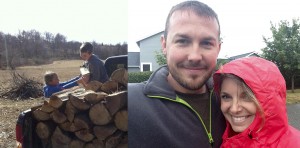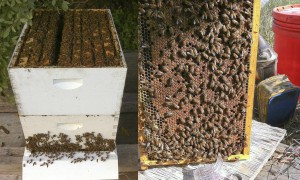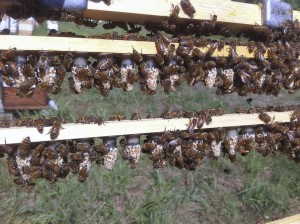Cory Stevens lives in southeast Missouri. There are some hives of hobbyists some miles from him. A larger beekeeper is 7-8 miles from him, but he uses Cory Stevens’ queen cells.
 The whole Stevens family works together
The whole Stevens family works together
Started with resistance traits
Cory Stevens ceased treatments for Varroa mites in most of his then 20 colonies 8 years ago. 6 years ago the number had grown to around 45 colonies. Then a few got some formic acid. Then no more treatment. When he stopped treating he had acquired queens of different origins with resistance traits, VSH from Tom Glenn and Pol line Hygienic Italians crossed with local ferals.
 Healthy colonies are the base for a thriving bee operation.
Healthy colonies are the base for a thriving bee operation.
Low winter losses initially
Initially he had very low annual losses. He has brought in new stock every year besides breeding from his best lines. This hasn’t been good for the development of his stock so he has stopped that and will focus on selecting from his own best colonies. He will evaluate the need for bringing in new stock again later.
 He will now focus on breeding from his own selected lines.
He will now focus on breeding from his own selected lines.
Increased winterlosses
Winter losses has always been lower than average nation wide. But the last years it has reached 30%.The winter of 2014-15 he lost 60% of 95 wintered. 45 of those (47%) were too small 5-frame nucs. The winter was severe and all of those nucs died. He says it was his fault, not the bees’. The winter losses 2015-16 will be much lower, it looks like cose to 20 %.
Initially some viruses
In the beginning when he saw more than a few bees with crippled wings (DWV) and K-wings (KWV) two different viruses, followers of Varroa and Tracheal mites respectively, he requeened those hives. Today he never sees any crippled wings. A few K-wings can be seen.
Removal of infested drone brood developed
Initially he didn’t see removal of varroa infested drone brood by the bees, only Varroa infested worker brood (in which the mites have offspring – VSH). But after breeding from the best survivors without any treatment he has seen this trait developing. He thinks that’s good as Varroa prefer drone brood and should continue doing it leaving as much worker brood as possible alone.
 He has developed his stock to remove Varroa infested drone brood. It has simply turned up when breeding from the best survivors.
He has developed his stock to remove Varroa infested drone brood. It has simply turned up when breeding from the best survivors.
Some characteristics
He doesn’t use small cell combs, but standard rite cell foundation. He does use screened bottom board on several hives, but he doesn’t think they contribute that very much to Varroa control.
Planned focus
This season he will check natural downfall to look for the percentage of mutilated mites. He will also be utilizing liquid nitrogen to test for hygienic behavior for breeding candidates. Some of his virgins will be inseminated with semen from ankle biters (mite ankels) from Purdue University to test if this will contribute to his stock. He will also put out more swarm traps to hopefully catch feral swarms.
The goal
Cory wintered 120 colonies last autumn. The goal now is adding 25-30 per year until he reaches 5-600. Then he will “retire”.
Are we able to order queens from Cory? Appreciate any info!!
You can ask him Karen: corystevens00@yahoo.com
Have a nice day!
It’s good that he didn’t give up and treat after taking some big losses. Many others would have. Great profile and great blog. Thank you.
Yes Bruce. I did, but I had a stock a didn’t want to loose and hade use the bees to put food on the table. Now I have realized at some point you have to stop anyway to be able to give the bees possibility to develop their adaptation to its full strength. So that’s what I’m implementing now.
I am wanting to get started into bees but have a limited money live on disablity, what and were do we start, Mid Mo, with crop fields all around us,
If you have only crop fields all around you that will be difficult. But maybe not impossible. To know that you have to try. If you have some bushes, patches of forest an the like amongst or besides and within half a mile from you or so it might work well: The bees might make it if they get some pollen from other sources than crops.
There is a Creek about 1/4 mile away, The place i had in mind has some trees on the fence and some Black berry bushes I have 3 Maul berry trees with other weeds and bushes, I am sorry if i sounded like it was Nothing but dirt to plow,
Thanks for the reply
No problem. I wish you good luck starting up with bees. Maybe I would start with a couple of TBH hives as the cost is comparatively lower than to start with a box hive set up, including extraction equipment. So you have to get hold of a couple of TBH hives and a couple of package bees, preferably from a treatment free beekeeper, or a small cell bee supplier. It’s easier to succeed if there are few or no other beekeeper around within 2 miles. And if you start with two instead of one. Also if you are lucky to get a mentor. I’m too far away in Sweden.